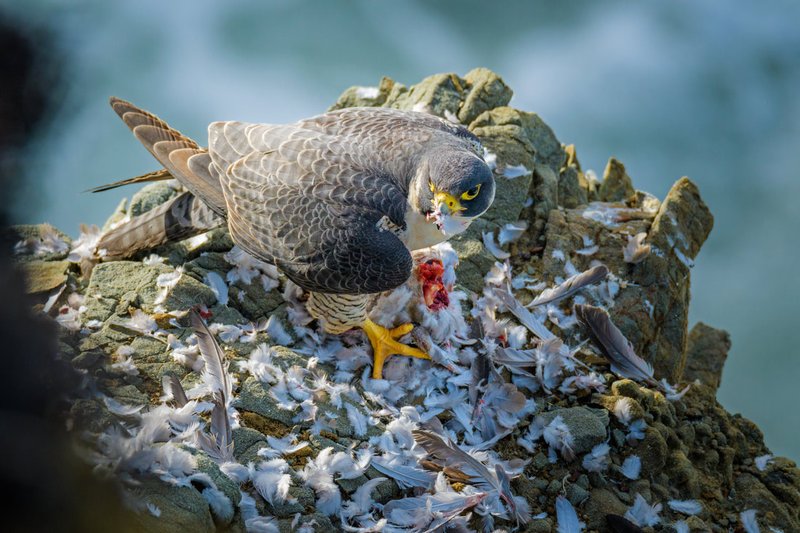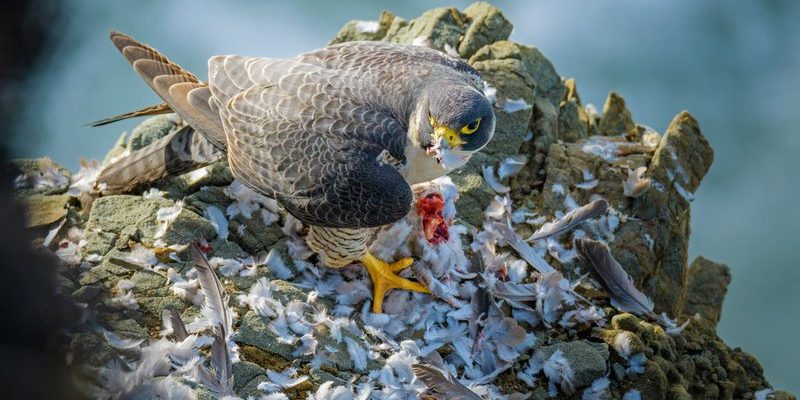
Falcon species like the Peregrine Falcon, known for its incredible dives, have adapted over time to master their environments. It’s almost as if nature designed these birds with a built-in toolkit specifically for survival. Their feeding habits and hunting techniques are so fascinating that they’ve been studied and admired by birdwatchers, scientists, and nature enthusiasts alike. So, let’s dive deeper into the fascinating world of falcon diets and their incredible hunting strategies.
Falcon Diet: What Do Falcons Eat?
When it comes to their diet, falcons are carnivorous hunters that primarily feast on other animals. Their meals mainly consist of small to medium-sized birds, making them expert aerial predators. You might be surprised to learn that falcons can consume a variety of species, including sparrows, doves, and even starlings.
Why are birds their primary meal choice? Here’s the thing: Birds are fast and agile, and so are falcons. Their swift movements allow them to catch their prey mid-flight. In addition to birds, some falcons also eat small mammals, reptiles, and insects. The flexibility in their diet allows them to adapt based on availability, which is key to their survival in different habitats.
Here are some common prey items for falcons:
- Small birds: Sparrows, finches, and pigeons.
- Mammals: Mice and voles.
- Reptiles: Small snakes or lizards.
- Insects: Grasshoppers and crickets.
It’s fascinating how a falcon’s diet can vary depending on where they live, showcasing their adaptability. For instance, a falcon in a coastal area may hunt seabirds, while one in a forested region might focus on smaller mammals.
The Incredible Speed of Falcons
You might be wondering: what makes falcons such effective hunters? One key factor is their astonishing speed. The Peregrine Falcon holds the title for the fastest bird on the planet, reaching speeds of over 240 miles per hour during its hunting dive, also known as a stoop. This phenomenal speed allows them to surprise their prey, making it almost impossible for the birds below to react in time.
To visualize this, think about how a quarterback throws a football. If they can throw it quickly and accurately, the receiver has a much better chance of catching it. Similarly, a falcon’s speed gives it the advantage over its prey, allowing for a successful catch.
In addition to speed, falcons use *keen eyesight* to spot their targets from high altitudes. They have excellent vision, allowing them to see movements far below as they soar through the sky. This combination of speed and sight makes them incredibly effective hunters.
Hunting Techniques: How Falcons Catch Their Prey
Falcons are not just fast; they are also skilled strategists when it comes to hunting. They use various techniques to catch their prey. One of the most common methods is known as the stoop. During this maneuver, the falcon will soar high into the sky and then dive down at breakneck speeds toward its target, using gravity to increase its velocity. The sheer force of this dive often overwhelms the unsuspecting prey.
Another technique related to their hunting prowess is called “perch hunting.” In this method, falcons will perch themselves on a high spot, such as a tree branch or a ledge, and patiently watch for their next meal. When they spot a potential target, they launch themselves into the air and dive down with precision.
But wait, there’s a twist! Some falcons also employ a technique called chasing. Here’s how it works: if the target manages to escape the initial dive, the falcon can pursue it through sharp turns and quick maneuvers, often outsmarting the prey. You could say they’re the ultimate pursuers in the animal kingdom.
Group Hunting vs. Solo Hunting
Most falcons prefer to hunt alone, showcasing their independence and skill. However, some species, like the *Laggar Falcon*, have been observed hunting in pairs or even small groups. Group hunting can enhance their success rate, especially when they are targeting larger or more difficult prey.
Imagine two skilled athletes working together to outplay their opponents. In a similar way, falcons can circle their prey, forcing it to make panic-driven decisions and then capitalize on those mistakes. This teamwork enables them to be successful in situations that might be challenging for a solo hunter.
While solitary hunting is common, it highlights the flexibility of falcons. This adaptability is vital for survival and allows them to thrive in different environments.
Adaptations That Aid in Hunting
Falcons have developed several adaptations that enhance their hunting abilities. One significant feature is their strong, sharp beak, which is perfect for tearing into flesh. Their beaks are hooked, which helps them grip their prey tightly and consume it efficiently.
Another crucial adaptation is their talons. Falcons have incredibly powerful feet equipped with sharp talons that can grasp prey securely. This strength allows them to capture their meals mid-flight or from the ground. You might compare a falcon’s talons to a pair of specialized tools; they’re purpose-built for their role as predators.
Beyond physical adaptations, falcons possess a unique ability to navigate and hunt in various weather conditions. Their keen senses guide them through rain, wind, and even low-light situations, ensuring they can find food in less-than-ideal conditions. These adaptations set them apart in the avian world.
The Role of Falcons in the Ecosystem
Falcons play an essential role in maintaining the balance of their ecosystems. By controlling the population of smaller birds and mammals, they prevent overpopulation, which can lead to resource depletion. This balance is crucial for the health of the environment.
Additionally, their hunting behavior can positively impact the variety of species in an area. By preying on weaker or sick animals, falcons contribute to the overall health of prey populations. It’s the natural cycle of life in action, demonstrating how each species plays a role in the ecosystem.
Understanding the importance of falcons helps us appreciate their value beyond their impressive hunting skills. They embody the elegance and power of nature, reminding us of how interconnected all living things truly are.
Conservation and Falcon Protection
Unfortunately, many falcon species face threats from habitat loss, pesticide use, and climate change, which can significantly impact their populations. Conservation efforts are underway to help protect these beautiful birds and their habitats. Organizations are working to create protected areas and educate the public about the importance of preserving natural environments.
By promoting awareness and appreciation for these incredible hunters, conservationists hope to ensure that future generations can continue to marvel at falcons in the wild. Whether it’s through birdwatching or participating in local conservation events, there are many ways for us to play a role in protecting these magnificent creatures.
In conclusion, falcons are remarkable hunters with a diet and hunting strategy that highlights their adaptability and skills. From their stunning speed to their strategic techniques, they exemplify the wonders of nature. Whether soaring high above us or skillfully catching their prey, falcons remind us of the beauty and complexity of the wildlife around us. So, the next time you spot a falcon flying through the sky, take a moment to appreciate the incredible journey it undertakes to survive.

